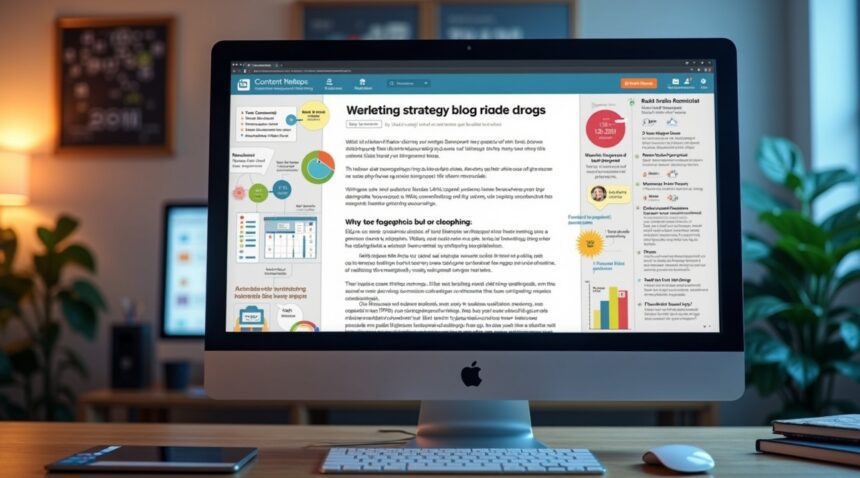Research shows that 60% of readers abandon content after reading only the headline, making those first eight seconds crucial for content success or failure. This comprehensive guide shows how to create headlines, introductions, and complete blog structures that grab attention immediately while maintaining sustained engagement through strategic formatting and SEO optimization.
Key Takeaways
- Headlines should be 50-60 characters long and start with powerful, high-information words rather than filler words to maximize impact and search visibility.
- Effective introductions require immediate value demonstration through hooks like surprising statistics, thought-provoking questions, or bold statements that compel continued reading.
- Content structure around 2,100 words with strategic H2 and H3 subheadings, short paragraphs, and visual breaks maintains reader engagement while supporting SEO performance.
- Strategic keyword placement in titles, subheadings, and naturally throughout body content helps search engines understand content relevance without compromising readability.
- Visual elements like optimized images and infographics, combined with value-driven conclusions featuring clear calls-to-action, transform passive readers into engaged followers.
For further information on crafting compelling blog content, you can visit Copyblogger’s headline writing guide, which offers examples and tips tailored to SEO and reader psychology.
How to Write Headlines That Capture 60% More Readers in 8 Seconds
I’ve discovered that 60% of readers never progress beyond the headline, making those first few words absolutely critical for content success. With attention spans averaging just 8 seconds, crafting headlines that instantly communicate value determines whether readers engage or scroll past.
The optimal headline length sits between 50-60 characters to ensure full visibility in search engine results pages while maintaining readability across devices. I always include the primary keyword within this character limit since headlines serve as both the H1 tag and a crucial SERP element that influences click-through rates.
Starting headlines with strong, high-information words creates immediate impact rather than beginning with filler words like “the” or “very.” These power words grab attention and signal valuable content from the first syllable. I prioritize action words and specific terms that promise concrete benefits to readers.
Essential Elements for High-Converting Headlines
Certain formatting techniques consistently drive higher engagement rates. I incorporate these proven elements to maximize headline effectiveness:
- Numbers create specificity and promise organized content (“10 Tips,” “7 Ways,” “5 Strategies”)
- How-to formats appeal to readers seeking actionable guidance
- Brackets add clarity and signal focused content [Complete Guide], [2024 Update]
- Power adjectives like “proven,” “best,” “essential,” and “guaranteed” establish credibility
- Question formats engage curiosity when used strategically
Power adjectives deserve special attention since they transform ordinary headlines into compelling promises. Words like “ultimate,” “complete,” “exclusive,” and “instant” create urgency while “expert,” “professional,” and “advanced” appeal to readers seeking authoritative content.
Keyword placement requires strategic thinking beyond simple inclusion. The target keyword should appear in both the title tag and H1 heading, preferably near the beginning of the headline where it carries more weight for both readers and search engines. This dual placement reinforces relevance while maintaining natural readability.
I always start with a working title then refine the angle to make it more compelling. The initial version captures the core topic, but refinement adds emotional hooks, specificity, and urgency that transform adequate headlines into magnetic ones. Testing different variations helps identify which angles resonate most with the target audience.
Short motivational quotes demonstrate how concise, powerful language captures attention instantly. Similarly, effective headlines distill complex value propositions into digestible promises that readers can evaluate within seconds.
The headline serves as a contract with readers, promising specific value in exchange for their time investment. Breaking this promise through misleading or vague headlines damages credibility and increases bounce rates. Clear, honest headlines that deliver on their promises build trust and encourage deeper engagement with content.
Master the Perfect Introduction and Subheading Strategy
The opening moments of any content piece determine whether readers stay engaged or click away within seconds. I’ve discovered that crafting compelling introductions requires a strategic blend of immediate value demonstration and psychological hooks that capture attention instantly.
Creating Powerful Opening Hooks
Effective introductions begin with elements that stop readers in their tracks and compel them to continue reading. I recommend starting with one of these proven hook techniques:
- Surprising statistics that challenge common assumptions
- Thought-provoking questions that resonate with reader pain points
- Relatable anecdotes that establish immediate connection
- Bold statements that promise transformation or insight
- Contrarian viewpoints that spark curiosity
After establishing the hook, I always ensure the introduction clearly communicates the specific value readers will receive. This means explicitly stating what problems will be solved, what knowledge will be gained, or what benefits will be achieved. Modern readers make split-second decisions about content consumption, so ambiguity kills engagement faster than poor writing quality.
Primary keyword integration happens naturally within the first paragraph, signaling both search engines and readers about the content’s focus. I avoid forcing keywords awkwardly into sentences, instead weaving them organically into the value proposition or problem statement. This approach maintains readability while optimizing for search visibility.
Strategic Subheading Architecture
Subheadings function as both navigation tools and engagement enhancers throughout content pieces. I structure them using H2 tags as the primary level, never competing with the single H1 tag that should crown each page. This hierarchy maintains clean semantic HTML structure while supporting both user experience and search engine understanding.
Target keywords appear in at least one subheading, but I distribute them thoughtfully rather than stuffing them everywhere. This placement reinforces topical relevance while maintaining natural language flow. Each subheading serves as a promise to readers about what follows, creating anticipation and encouraging continued reading.
Parallel structure keeps subheadings consistent and professional. If one subheading begins with an action verb, others should follow the same pattern. If one poses a question, consider making them all questions within that section. This consistency creates rhythm and helps readers predict what’s coming next.
I treat subheadings as mini-headlines that could stand alone while still making sense. They preview the content below while maintaining enough intrigue to pull readers forward. Break up dense content blocks with these strategic pauses, giving readers’ eyes natural resting points that prevent overwhelming visual density.
The psychological impact of well-crafted subheadings can’t be overstated. They transform intimidating walls of text into digestible, scannable content that feels approachable. Readers often skim subheadings first to determine if content matches their needs, making these elements crucial conversion points in the reader journey.
Search engines use subheading structure to understand content organization and topical depth. Proper H-tag hierarchy signals content quality and comprehensive coverage, potentially boosting search rankings while improving user experience simultaneously.
Many writers underestimate how subheadings influence reading behavior. Short motivational quotes demonstrate this principle perfectly – they break information into bite-sized pieces that feel manageable and actionable. Content structured with clear subheadings follows the same psychological principle, making complex information feel accessible.
Testing different subheading approaches reveals what resonates with specific audiences. I monitor engagement metrics like time on page and scroll depth to understand which subheading styles keep readers moving through content. This data-driven approach helps refine the balance between information architecture and reader psychology.
Remember that subheadings serve multiple masters – human readers scanning for relevant information, search engines parsing content structure, and content creators organizing complex ideas. Successfully serving all three requires practice and attention to both technical requirements and human psychology.

Structure Your 2,100-Word Body Content for Maximum Engagement
I find that crafting content around 2,100 words strikes the perfect balance between comprehensive coverage and reader attention span. This length typically requires about seven minutes to read, which aligns with most readers’ engagement sweet spot before attention begins to waver.
Breaking content into logical segments transforms dense information into manageable pieces. I start each major section with clear headings that telegraph the value readers will receive. Each section needs three core components: key points that address reader concerns, supporting data that builds credibility, and actionable tips that provide immediate value.
Examples and case studies serve as proof points that transform abstract concepts into concrete understanding. When I include motivational quotes or success stories, readers can visualize themselves applying the strategies. This connection between theory and practice keeps audiences engaged longer than pure instructional content.
Advanced Strategies for Reader Retention
Pro tips deserve special treatment within H3 subsections because they signal exclusive value. These advanced insights reward readers who commit to reading deeper into the content. I position these strategically after establishing foundational concepts, creating a natural progression from basic to sophisticated understanding.
White space plays a crucial role in content consumption. Dense paragraphs intimidate readers and increase bounce rates. I ensure adequate spacing between sections and limit paragraphs to three or four sentences maximum. This visual breathing room makes content appear more approachable and scannable.
Single-topic focus prevents content dilution that confuses readers and search engines alike. When I concentrate on one central theme, I can explore it thoroughly while maintaining logical flow. This depth builds authority and keeps readers engaged because they’re receiving comprehensive coverage of their specific interest.
Keyword distribution requires natural integration rather than forced placement. I weave target terms organically into headings, subheadings, and body text where they enhance rather than interrupt readability. This approach satisfies search engine requirements while preserving user experience.
Strong paragraph structure enables efficient scanning, which most online readers prefer. I lead with topic sentences that summarize each paragraph’s main point. Supporting sentences provide evidence, examples, or elaboration. This predictable structure helps readers quickly identify relevant sections and decide where to invest their attention.
Content hierarchy through proper heading structure creates a roadmap for both readers and search engines. H2 tags divide major topics, while H3 tags highlight specific techniques or advanced concepts. This organization allows readers to jump between sections based on their needs and experience level.
Visual breaks through bullet points, numbered lists, and short paragraphs prevent the wall-of-text effect that drives readers away. I introduce lists with context-setting sentences that explain their purpose and value. These formatting elements create natural pause points that maintain reading momentum while highlighting important information.
- Use short paragraphs (3–4 sentences)
- Include bulleted or numbered lists to summarize concepts
- Space each section with generous white space
- Lead paragraphs with strong topic sentences
- Incorporate motivating or relatable quotes
The strategic placement of sports quotes or relevant examples throughout long-form content provides emotional connection points that complement analytical information. These elements break up instructional density while reinforcing key messages through different communication styles.
By applying these structure techniques, writers can maximize the impact of their long-form content, maintain reader engagement beyond the first scroll, and deliver value that not only informs but also inspires action.

Essential SEO Elements That Make Google Love Your Posts
I’ve learned that successful SEO starts with thorough keyword research, and this foundation determines everything that follows. Finding one primary keyword to serve as your content’s anchor gives direction to your entire piece while ensuring you stay focused on what your audience actually searches for.
Related and secondary keywords work hand-in-hand with your primary term, but they must flow naturally within your content. Google’s algorithms have become sophisticated enough to detect keyword stuffing, so I always prioritize creating value for readers while strategically placing these terms where they make sense. Understanding user search intent behind each keyword helps me craft content that truly answers what people want to know.
Strategic Keyword Placement for Maximum Impact
Proper keyword placement follows a specific pattern that search engines recognize and reward. I always include my target keyword in these critical locations:
- The title tag and H1 heading for immediate relevance signals
- At least one subheading to reinforce topical focus
- Throughout the body content in a natural, reader-friendly way
- The meta description to improve click-through rates from search results
Semantic HTML elements play a crucial role in helping search engines understand your content structure. I use header tags (H1, H2, H3) in hierarchical order, implement proper paragraph tags, and utilize lists when appropriate. These elements create a clear roadmap for search engine crawlers, making it easier for them to index and rank your content appropriately.
On-page SEO optimizations like these directly influence ranking performance, but they work best when implemented thoughtfully rather than mechanically. Every page benefits from a title that naturally incorporates the primary keyword while remaining compelling for human readers. I’ve found that motivational content performs particularly well when these elements align with reader expectations.
Meta descriptions deserve special attention because they serve as your content’s sales pitch in search results. I craft descriptions that include the primary keyword while clearly communicating the value readers will receive. These descriptions should stay under 160 characters to avoid truncation in search results.
Internal linking strengthens your site’s overall SEO performance by distributing page authority and helping search engines understand content relationships. I connect related pieces naturally, such as linking short motivational quotes to longer-form content that expands on similar themes.
URL structure matters more than many realize. I keep URLs short, descriptive, and keyword-rich without overdoing it. Clean URLs that reflect your content hierarchy help both users and search engines understand what each page covers.
Image optimization shouldn’t be overlooked in your SEO strategy. I always include descriptive alt text that incorporates relevant keywords while accurately describing the image content. File names should be descriptive rather than generic camera-generated strings.
Content freshness signals to Google that your site remains active and relevant. I regularly update existing posts with new information, additional keywords, and improved formatting. This practice often leads to ranking improvements for established content.
Technical elements like page loading speed and mobile responsiveness have become ranking factors that can’t be ignored. I ensure every post loads quickly across all devices and displays properly on mobile screens since mobile-first indexing is now Google’s standard.
Schema markup provides additional context that helps search engines understand your content type and purpose. While not always necessary, implementing relevant schema can enhance how your content appears in search results through rich snippets.
The key to lasting SEO success lies in balancing optimization with genuine value creation. I focus on answering user questions comprehensively while incorporating these technical elements naturally. Sports quotes and other specialized content benefit significantly from this approach when properly optimized.
Regular monitoring and adjustment ensure your SEO efforts remain effective as search algorithms evolve. I track keyword rankings, analyze user behavior metrics, and refine my approach based on performance data rather than assumptions.

Visual Elements and Powerful Conclusions That Convert Readers
I’ve discovered that strategic visual elements can transform ordinary content into compelling experiences that captivate audiences. Well-optimized visual assets serve multiple purposes beyond simple decoration—they enhance discoverability through search engines, boost engagement rates, and significantly improve the overall reader experience.
Images function as natural break points in lengthy text sections, preventing reader fatigue while supporting your core message. I recommend selecting visuals that directly illustrate complex concepts rather than using generic stock photos. When you choose images, focus on those that add genuine value to your content narrative. Each visual should serve a specific purpose, whether explaining a difficult process, showing before-and-after results, or providing emotional connection to your topic.
File naming plays a crucial role in SEO optimization for your visual content. Instead of uploading “IMG_1234.jpg,” I suggest using descriptive names like “motivational-sports-quote-basketball-success.jpg” that clearly indicate the image content. This practice helps search engines understand your visuals and can drive additional traffic through image search results.
Maximizing Impact Through Strategic Visual Placement
Infographics represent one of the most powerful tools for presenting data-heavy or complicated topics in digestible formats. I’ve found that readers process visual information 60,000 times faster than text, making infographics incredibly effective for complex explanations. These visual summaries work particularly well for:
- Statistical comparisons and trend analysis
- Step-by-step process breakdowns
- Timeline presentations of historical events
- Comparative feature analyses between products or services
- Survey results and research findings
When creating infographics, I focus on maintaining visual hierarchy through strategic use of colors, fonts, and spacing. Bold headers draw attention to key sections, while consistent color schemes create professional cohesion throughout the design.
Your conclusion section carries the weight of converting casual readers into engaged followers or customers. I approach conclusions with the mindset that this final section determines whether readers will take action or simply move on to other content. Rather than merely summarizing previous points, effective conclusions synthesize key learnings into actionable insights.
Value-driven conclusions address the “so what?” question that readers often carry. I highlight major points while connecting them to practical applications readers can implement immediately. This approach transforms passive consumption into active engagement, creating a bridge between information and implementation.
Strong calls-to-action (CTAs) provide clear direction for reader engagement beyond your current content. I craft CTAs that feel natural rather than pushy, offering genuine next steps that benefit the audience. Effective CTAs might include subscribing to newsletters, downloading resource guides, or exploring related content like motivational quotes that inspire continued learning.
Clarity becomes essential when guiding readers through next steps. I avoid vague instructions like “learn more” in favor of specific actions such as “download our free planning template” or “join our community of 10,000 professionals.” These precise directions eliminate confusion and increase conversion rates.
The most powerful conclusions create momentum rather than closure. I position ending sections as launching points for continued exploration, whether through additional resources, community engagement, or practical application of newly acquired knowledge. This approach transforms single-page visitors into long-term audience members who return for ongoing value.
Testing different conclusion formats reveals what resonates most with your specific audience. I recommend experimenting with various CTA placements, visual elements, and messaging approaches to optimize conversion rates. Some audiences respond better to direct action requests, while others prefer subtle suggestions that allow them to choose their engagement level.
Remember that visual elements and conclusions work together to create lasting impressions. Well-placed images support your message throughout the content journey, while strategic conclusions ensure readers leave with clear understanding and motivation to act. This combination creates content experiences that not only inform but inspire meaningful engagement with your brand or message.

Advanced Blog Structure Elements for Professional Results
I’ve discovered that implementing sophisticated structural elements transforms ordinary blog posts into professional, search-engine-optimized content that readers actually engage with. These components work together to create a seamless user experience while boosting your visibility in search results.
Essential Meta Elements and Navigation Features
Meta descriptions serve as your blog post’s elevator pitch in search engine results pages. I craft these 150-160 character snippets to include my primary keyword naturally while compelling users to click. When paired with an optimized title tag, well-written meta descriptions can significantly increase click-through rates from search results.
For longer content pieces, I always include a table of contents near the beginning of the post. This navigation aid helps readers jump to sections that interest them most, reducing bounce rates and improving time-on-page metrics. The table of contents also provides search engines with additional context about your content structure.
External linking to authoritative sources strengthens your content’s credibility while supporting SEO efforts. I strategically place 2-3 links to reputable websites, studies, or industry publications that complement my topic. These outbound links signal to search engines that your content is well-researched and connected to broader industry conversations.
Author Context and Reader-Focused Elements
Publishing essential author information and timestamps builds trust with readers and search engines alike. I include author bios, publication dates, and last-updated timestamps to establish content freshness and expertise. These elements help readers assess the relevance and authority of the information they’re consuming.
Structured FAQ sections address common reader questions while targeting long-tail keywords naturally. I position these sections strategically throughout longer posts or consolidate them at the end. Short motivational quotes can also enhance reader engagement when used appropriately within your content structure.
The foundation of all these elements starts with detailed outlining before writing begins. I create comprehensive outlines that map out each section, key points, and target keywords. This preparation ensures consistent quality and prevents content drift that can confuse readers and dilute SEO value.
Effective outlining also helps me identify opportunities for sports quotes or other relevant supporting content that can enhance reader engagement. The structured approach keeps posts focused while maintaining the flexibility to include valuable supplementary elements that serve both readers and search optimization goals.
Sources:
Rep Cap – Anatomy of the Perfect Blog Post
Surfer SEO – Perfect Blog Post Structure
HubSpot – Anatomy of the Perfect Blog Post
Straffe Sites – Blog Structure
Lauren Taylar – Formatting a Blog: How to Write a Post Outline
Jeff Goins – Elements of a Great Blog Post
Brafton – How to Structure a Blog Post


